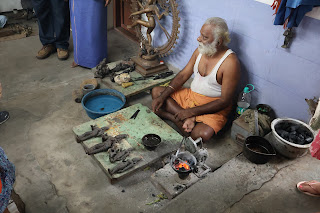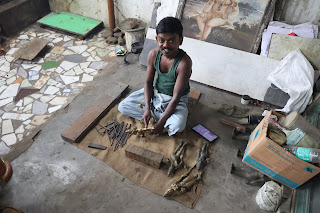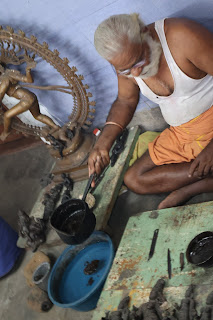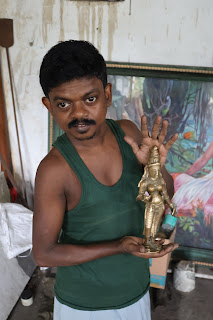Tamil Nadu is one of the leading bronze casting centres of India and the
images cast conform to the Pallava, Chola, Pandyan and Nayaka periods.
Practitioners of this craft are found in Thanjavur district. The artisans
called Stapathis/icon makers claim direct descent from Vishwakarma, the divine
architect.
Icon making is a labourious, concentrated, time-consuming job requiring a
number of tools. The lost wax or cire perdue method is used: the image is
moulded in wax and coated with clay strengthened with ground cotton, salt and
charred husk. It is then reinforced with a steel wire. The model is then
heated on a ground furnace and the wax drains out through a fine pouring
channel constructed at the base of the wax model. The bronze is heated, melted
and poured into the mould from where the wax has been removed. The mould is
cooled, broken very carefully and the image is removed. The finishing,
burnishing and perfecting of the image is done manually. The figures are
usually, but some can be hollow. In this craft, the coconut leaf is used as a
measuring instrument, with the folds on the leaf as measures. The wax model's
configuration is very important as the final shape of the image depends on it.
Various types of clay are used to coat the image at each stage.
Apart from the classical bronzes Tamil Nadu has folk bronzes which are cast
mainly at Thanjavur and Salem. The figures include animals, local deities and
small female figures. The metal is cast on a clay model. There is a great
resemblance to terracotta figures suggesting that these are the main
inspiration; the craft continues as a village craft. The images cast are used
as lamps, votive offerings, temple decorations and toys.
|
Process
-
Model-making. An artist or mould-maker creates an original
model from wax, clay, or another material. Wax and oil-based clay are
often preferred because these materials retain their softness.
-
Mouldmaking. A mould is made of the original model or
sculpture. The rigid outer moulds contain the softer inner mould,
which is the exact negative of the original model. Inner moulds are
usually made of latex, polyurethane rubber or silicone, which is
supported by the outer mould. The outer mould can be made from
plaster, but can also be made of fiberglass or other materials. Most
moulds are made of at least two pieces, and a shim with keys is placed
between the parts during construction so that the mould can be put
back together accurately. If there are long, thin pieces extending out
of the model, they are often cut off of the original and moulded
separately. Sometimes many moulds are needed to recreate the original
model, especially for large models.
-
Wax. Once the mould is finished, molten wax is poured into it
and swished around until an even coating, usually about 3 mm (1⁄8
inch) thick, covers the inner surface of the mould. This is repeated
until the desired thickness is reached. Another method is to fill the
entire mould with molten wax and let it cool until a desired thickness
has set on the surface of the mould. After this the rest of the wax is
poured out again, the mould is turned upside down and the wax layer is
left to cool and harden. With this method it is more difficult to
control the overall thickness of the wax layer.
-
Removal of wax. This hollow wax copy of the original model is
removed from the mould. The model-maker may reuse the mould to make
multiple copies, limited only by the durability of the mould.
-
Chasing. Each hollow wax copy is then "chased": a heated metal
tool is used to rub out the marks that show the parting line or
flashing where the pieces of the mould came together. The wax is
dressed to hide any imperfections. The wax now looks like the finished
piece. Wax pieces that were moulded separately can now be heated and
attached; foundries often use registration marks to indicate exactly
where they go.
-
Spruing. The wax copy is sprued with a treelike structure of
wax that will eventually provide paths for the molten casting material
to flow and for air to escape. The carefully planned spruing usually
begins at the top with a wax "cup," which is attached by wax cylinders
to various points on the wax copy. The spruing does not have to be
hollow, as it will be melted out later in the process.
-
Slurry. A sprued wax copy is dipped into a slurry of silica,
then into a sand-like stucco, or dry crystalline silica of a
controlled grain size. The slurry and grit combination is called
ceramic shell mould material, although it is not literally made of
ceramic. This shell is allowed to dry, and the process is repeated
until at least a half-inch coating covers the entire piece. The bigger
the piece, the thicker the shell needs to be. Only the inside of the
cup is not coated, and the cup's flat top serves as the base upon
which the piece stands during this process. The core is also filled
with fire-proof material.
-
Burnout. The ceramic shell-coated piece is placed cup-down in a
kiln, whose heat hardens the silica coatings into a shell, and the wax
melts and runs out. The melted wax can be recovered and reused,
although it is often simply burned up. Now all that remains of the
original artwork is the negative space formerly occupied by the wax,
inside the hardened ceramic shell. The feeder, vent tubes and cup are
also now hollow.
-
Testing. The ceramic shell is allowed to cool, then is tested
to see if water will flow freely through the feeder and vent tubes.
Cracks or leaks can be patched with thick refractory paste. To test
the thickness, holes can be drilled into the shell, then patched.
|
|
Pouring
-
Pouring. The shell is reheated in the kiln to harden the
patches and remove all traces of moisture, then placed cup-upward into
a tub filled with sand. Metal is melted in a crucible in a furnace,
then poured carefully into the shell. The shell has to be hot because
otherwise the temperature difference would shatter it. The filled
shells are then allowed to cool.
|
|
Release
-
Release. The shell is hammered or sand-blasted away, releasing
the rough casting. The sprues, which are also faithfully recreated in
metal, are cut off, the material to be reused in another casting.
|
|
Metal-chasing
-
Metal-chasing. Just as the wax copies were chased, the casting
is worked until the telltale signs of the casting process are removed,
so that the casting now looks like the original model. Pits left by
air bubbles in the casting and the stubs of the spruing are filed down
and polished.
|
See Also
Source
Location
Thanjavur Maratha Palace - Nataraja Hall
Thanjavur Maratha Palace - Nayak's Durbar Hall
Brihadisvara Temple, Thanjavur


































